Install Jetson Software with SDK Manager#
This section is intended to help you use the NVIDIA SDK Manager GUI to configure your development environment successfully.
Note
For Windows users: JetPack installation is now supported on Windows for Jetson AGX Orin and Jetson AGX Thor devices. This new method, available starting with JetPack 6.2.1, uses Windows Subsystem for Linux (WSL) to flash your Jetson device.
Windows Users
To detect and flash Jetson devices from Windows, an APX Driver is required when the device is in recovery mode. If a Jetson device is connected (or if multiple Jetson devices are connected), you may see the APX Driver Not Found error dialog on first detection. Click the APX Driver Instruction Guide button in the dialog, or APX Driver Instruction Guide, to launch the instruction web page, and follow the instructions there to install the APX Driver on your Windows Machine.
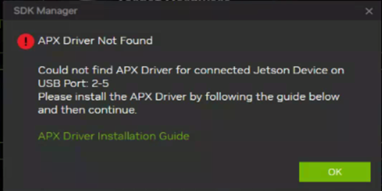
STEP 01: Set Up the Development Environment#
From the STEP 01 Development Environment window, select the following:
From the Product Category panel, select Jetson.
From the System Configuration panel, select the host machine, target hardware or both based on your needs. (Host machine or target hardware may not be available for some specific versions of SDKs.)

If a Jetson device is connected (or if multiple Jetson devices are connected), SDK Manager auto-selects it in the Target Hardware drop-down list. If your device is not automatically detected, click Refresh. You can hover over the message to display the detailed information of the detected hardware.
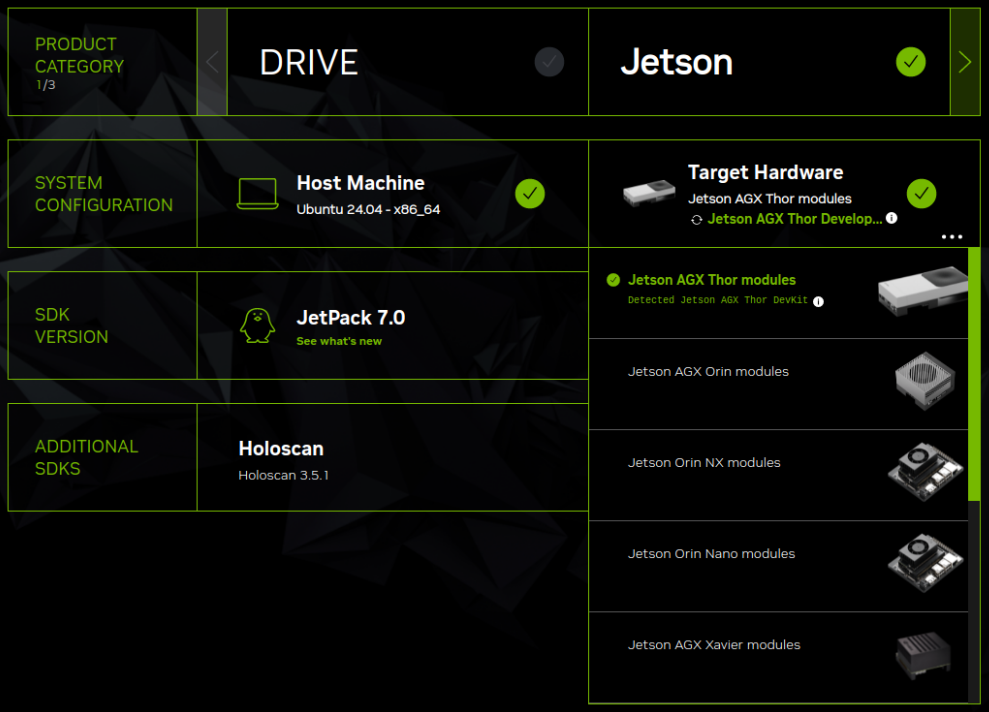
From the SDK Version panel, select the JetPack SDK version.
If relevant, select any Additional SDKs that you want to install.
An ellipsis (…) in the bottom right corner of a category box indicates that more than one option is available. Click on the ellipsis to show a drop-down menu of available options.
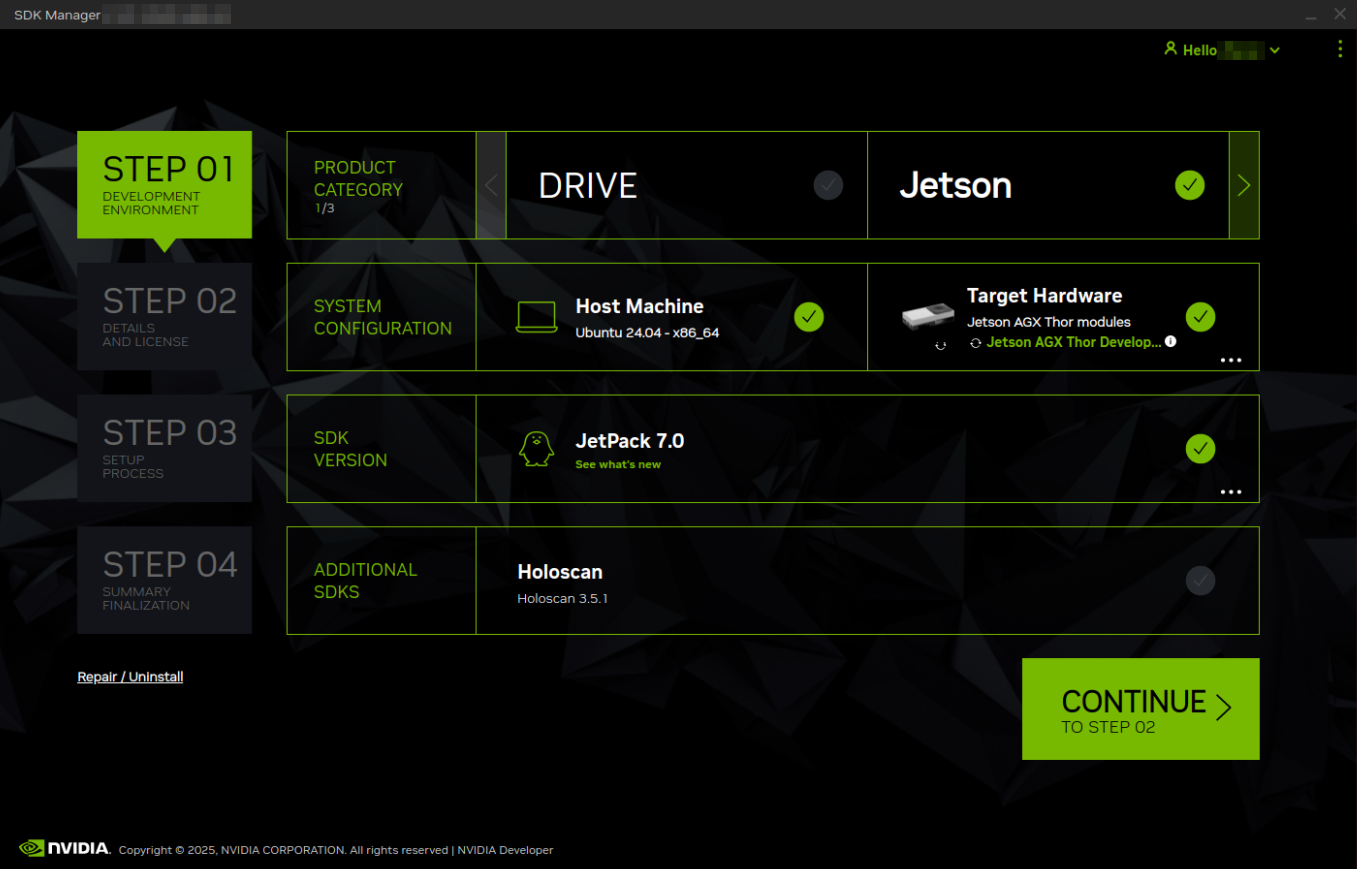
Note
Your display may differ from the one shown here. The information in this screen is populated from your NVIDIA user account access and permissions. If you don’t see your product category in the available selections, verify that your NVIDIA account is registered to the required programs.
Click Continue to proceed to the next step.
STEP 02: Review Components and Accept Licenses#
In STEP 02 Details and License, you can review the components that are installed as the Jetson Platform Services; some of the components can be selected or deselected.
To review the licenses, click on the license agreements hyperlink at the bottom of the page.
Enable the checkbox to accept the terms and conditions of the license agreements.
If you want SDK Manager to download all setup files to a location other than the default path, go to the Download folder located at the bottom of the screen, then update the path you want to use.

For more information about the Download and Install folders, refer to Offline Install.
Select Continue to proceed to the next step.
Windows Users
To flash your Jetson device on a Windows PC, SDK Manager automatically sets up a required WSL2 environment. This process includes:
Enabling WSL2 and installing a compatible Ubuntu instance.
Installing the customized WSL kernel (for Jetpack 6.x only).
Installing the Windows ADB tools (for Jetpack 7.x only).
Setting up USBIPD-Win to manage USB device connectivity with WSL.
When installing the customized WSL kernel (for Jetpack 6.x only), if you already have WSL installed, SDK Manager modifies your C:\Users\[user]\.wslconfig file. Your original configuration is automatically backed up to .wslconfig.bak in the same folder. To restore your settings, you can uninstall the OS image, which reverts the WSL configuration.
The WSL kernel and configuration files used by SDK Manager are located in:
C:\ProgramData\NVIDIA Corporation\SDKs\JetPack_[version]_Linux\
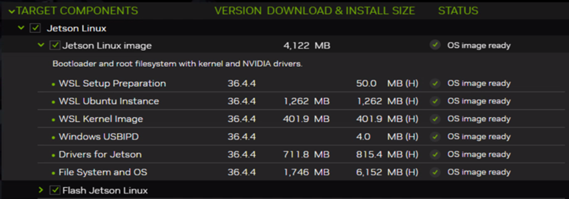
STEP 03: Installation#
Before the installation begins, SDK Manager prompts you to enter your
sudopassword.
The display shows the progress of the download and installation of the software.
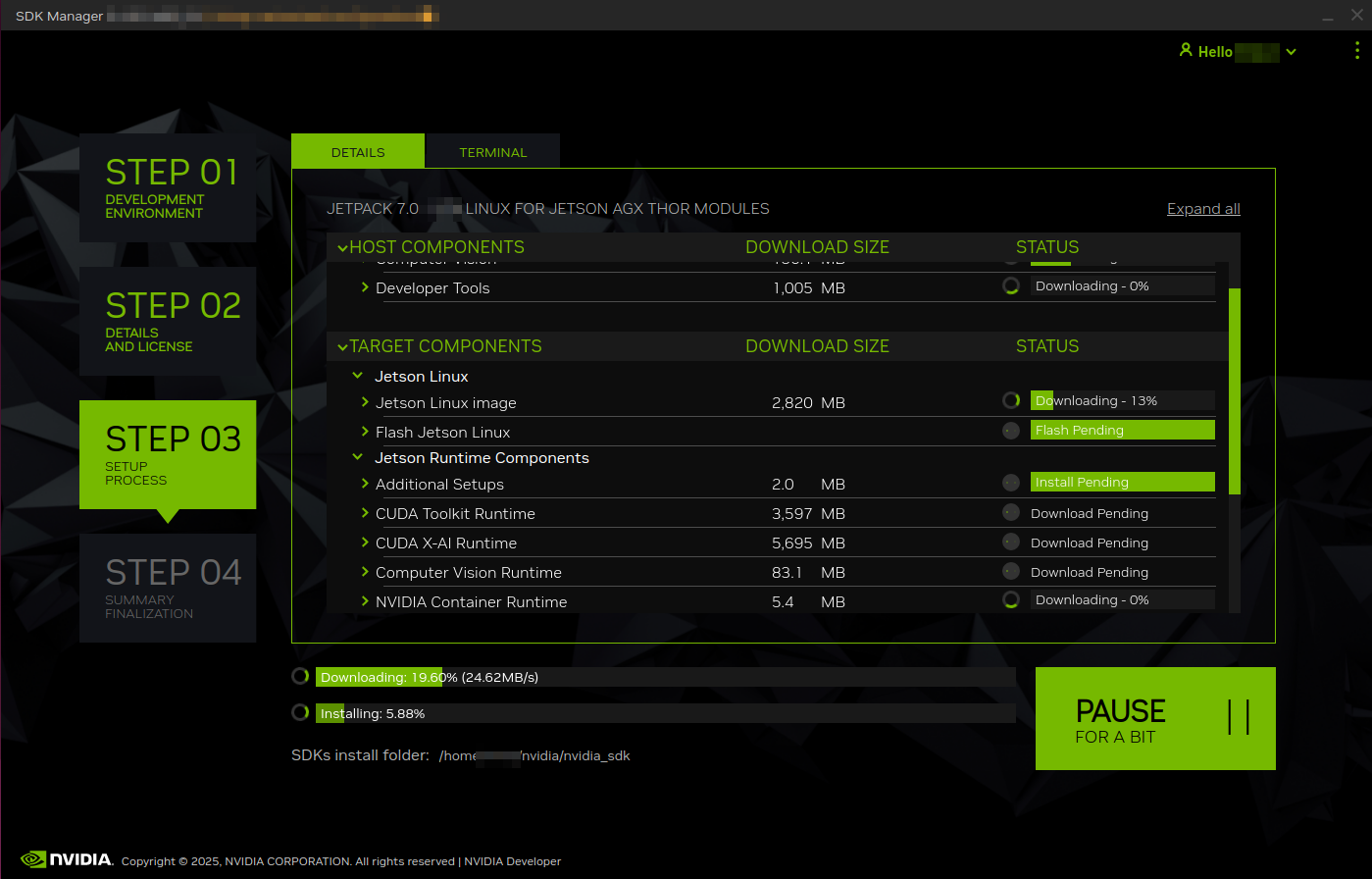
Select Pause / Resume to toggle the download and installation process.
At the top, you can toggle between the Details and Terminal tabs. The Terminal tab displays detailed information about the download and installation, with any errors highlighted.
On the Terminal tab, you can use the Filter text field to filter and search for specific information.
SDK Manager opens a dialog when it is ready to flash your target device. A prompt provides instructions for preparing your device to get it ready for flashing.
Note
The instructions in the flashing dialog vary based on your host and target environment settings.
Windows users: In order to flash the Jetson device on Windows, SDK Manager will set up the needed WSL2 environment on your Windows OS. This includes installing and enabling WSL2, installing a compatible Ubuntu WSL instance, and installing a compatible WSL Kernel. It will also install the USBIPD for binding and attaching the USB into WSL.
This process may change your WSL config file on C:Users[windows user].wslconfig if you had WSL installed already. Your original settings will be backed up to .wslconfig.bak under the same folder. To set it back, you uninstall the OS image, and this will automatically set your WSL config back.
If you want to see the WSL kernel file or config gz file used for generating the WSL kernel, you can find them under `C:ProgramDataNVIDIA CorporationSDKsJetPack_[version]_Linux`.
SDK Manager supports two options to put your Jetson target into Force Recovery Mode:
Automatic setup: set the target to Force Recovery Mode via remote command. This requires the device to be flashed and currently running. Follow the instructions and address the minimum storage requirement as stated in the flashing dialog.
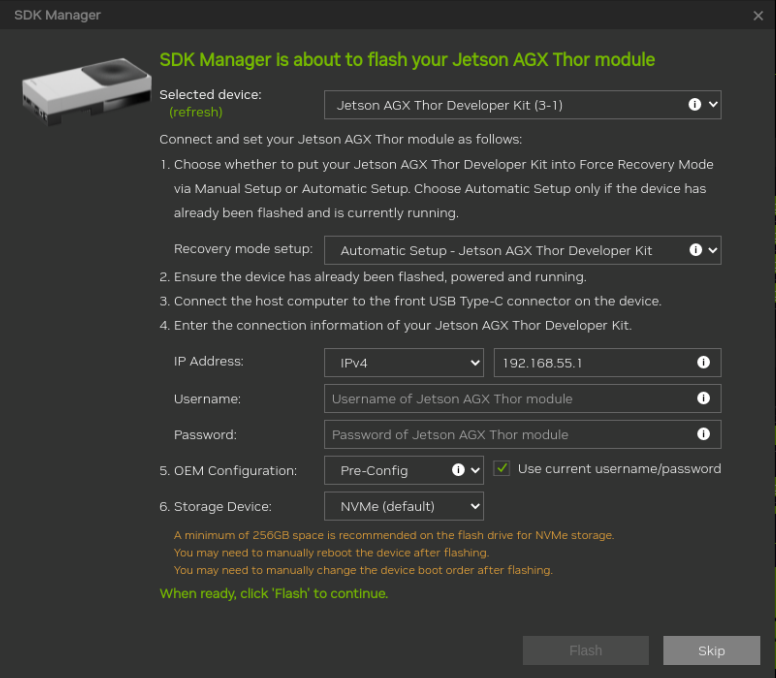
Manual setup: set the target to Force Recovery Mode via manual operations.
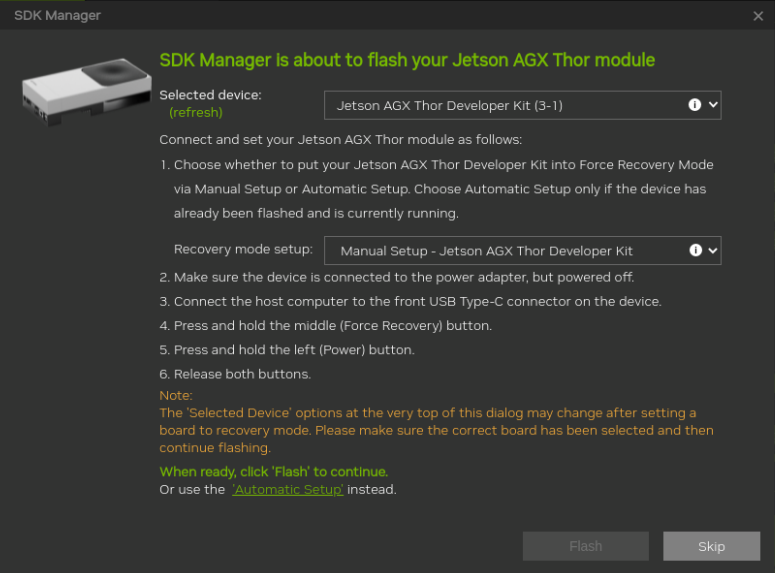
When the device is in recovery mode, you see the following:

You can also choose whether to pre-configure the OEM configuration.
Pre-Config: SDK Manager flashes the target with the predefined configuration, and there is no need to complete the System Configuration Wizard after flashing.
Runtime: No default configuration is set on the target, and you need to manually complete the System Configuration Wizard after flashing.
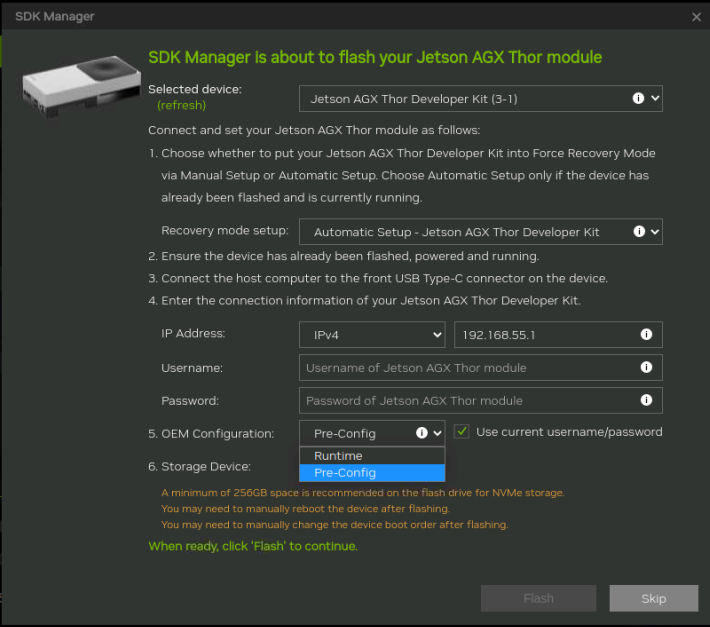
Flashing to an external storage is available for Jetson AGX Xavier, Orin, and Thor modules, as of Jetpack version 4.6. Select the external storage you would like to flash to (EMMC, SDCard, NVMe, USB, or Custom), per the available options in the flash dialog.

Windows users: You may see the dialog below when you try to flash the Jetson Orin device on the first try. This is a known issue caused by the USBIPD binding. If this occurs, power off the device, and then set it to recovery mode again should resolve this issue.

For Jetson AGX Thor Developer Kits, a full reboot (power off and then power on) is required after flashing. If the reboot information dialog pops up after flashing, please reboot the device and then continue.
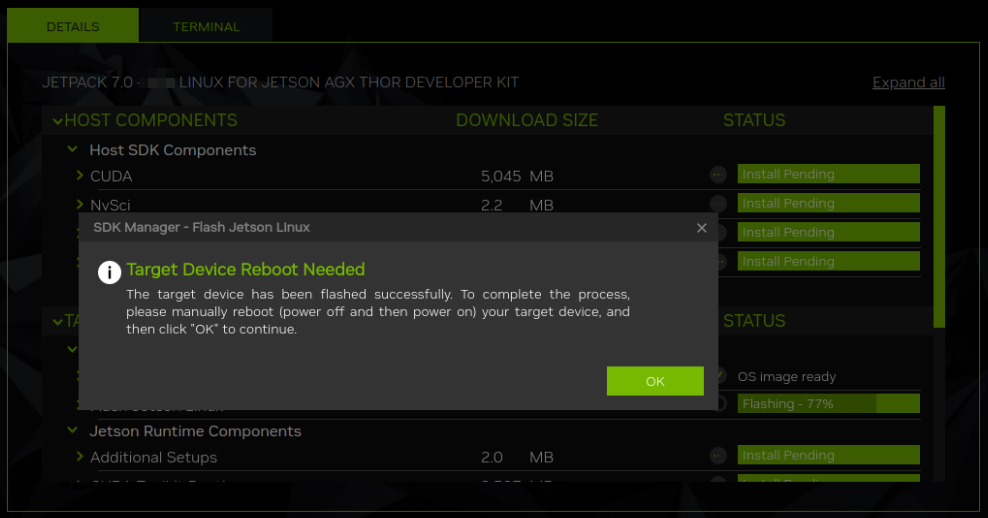
After SDK Manager completes the flashing process, the monitor connected to your Jetson system shows a prompt for initial setup.
As part of the initial setup process, select a username and password for the Jetson system.
After the initial setup process is complete, the Jetson system boots to the Linux desktop.
Enter the same username and password you created during the Jetson configuration into SDK Manager’s post-flash installation dialog.
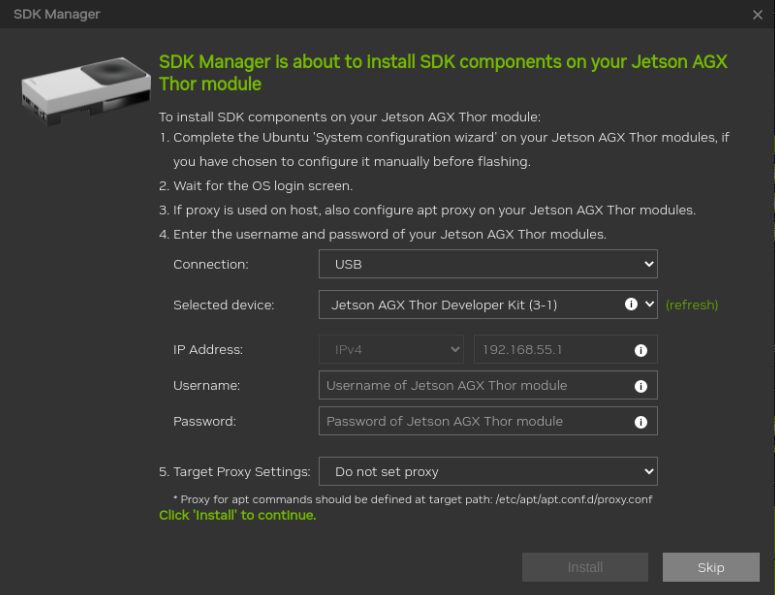
SDK Manager now completes the installation of the software libraries. Skipping this step does not install any SDK components on your target hardware, and keeps a clean operating system on your device.
STEP 04: Finalize Setup#
From STEP 04 Summary Finalization, there is a summary of the components that were installed, along with any warnings or errors that were encountered.
The Export Debug Logs link creates a ZIP file of all log files created during installation. This ZIP file is located in the same folder path where the SDK Manager installer downloaded all components.
Alternatively, click the menu icon in the top right corner of the window (”⋮”), and choose Export Debug Logs from the drop-down menu in the top-right corner.
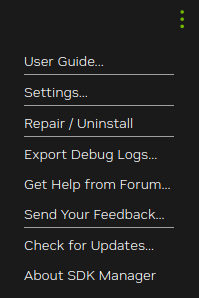
Consult the Error Messages for information about any errors you may encounter.
Click Finish and Exit to complete the installation.
Repair and Uninstall#
To update or uninstall an SDK on your system, launch SDK Manager again.
On STEP 01, under the installation step numbers, click the Repair/Uninstall hyperlink.

The Manage NVIDIA SDKs screen shows what has been installed on your system. You can select whether to repair a broken installation, update an existing SDK, or uninstall an SDK.

Recommended Recovery Steps#
There are many causes of various installation errors. Below is a checklist of common installation issues, which may help you recover from a broken installation.
Review the summary table to identify which component failed.
Expand the group with the “Error” status.
When you find the failed component, click the details icon to the right of Install Error to be redirected to the Terminal tab, which displays the exact error.

If the error is related to an environmental issue, such as a broken apt repository or missing prerequisite, try to fix it manually, then click the Retry Failed Items button.

Retrying the installation is also available in two other ways:
From STEP 01, use the Repair/Uninstall button to get to the Manage NVIDIA SDKs page. If needed, expand the SDK with the “Broken” status, then click Repair for the relevant part (Host or Target).
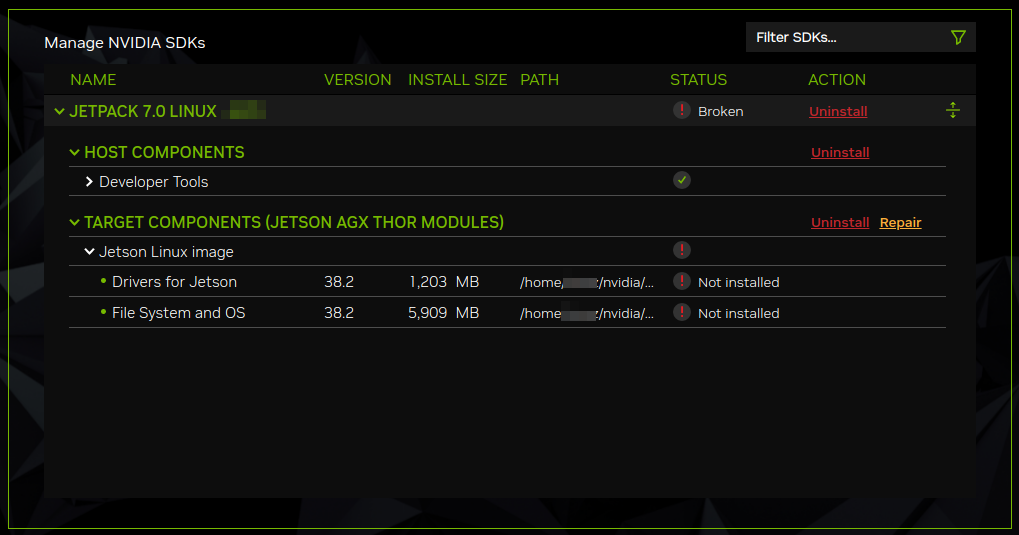
At STEP 01, select the required SDK and run through the installation again.
Finally, try to uninstall and reinstall the relevant SDK.